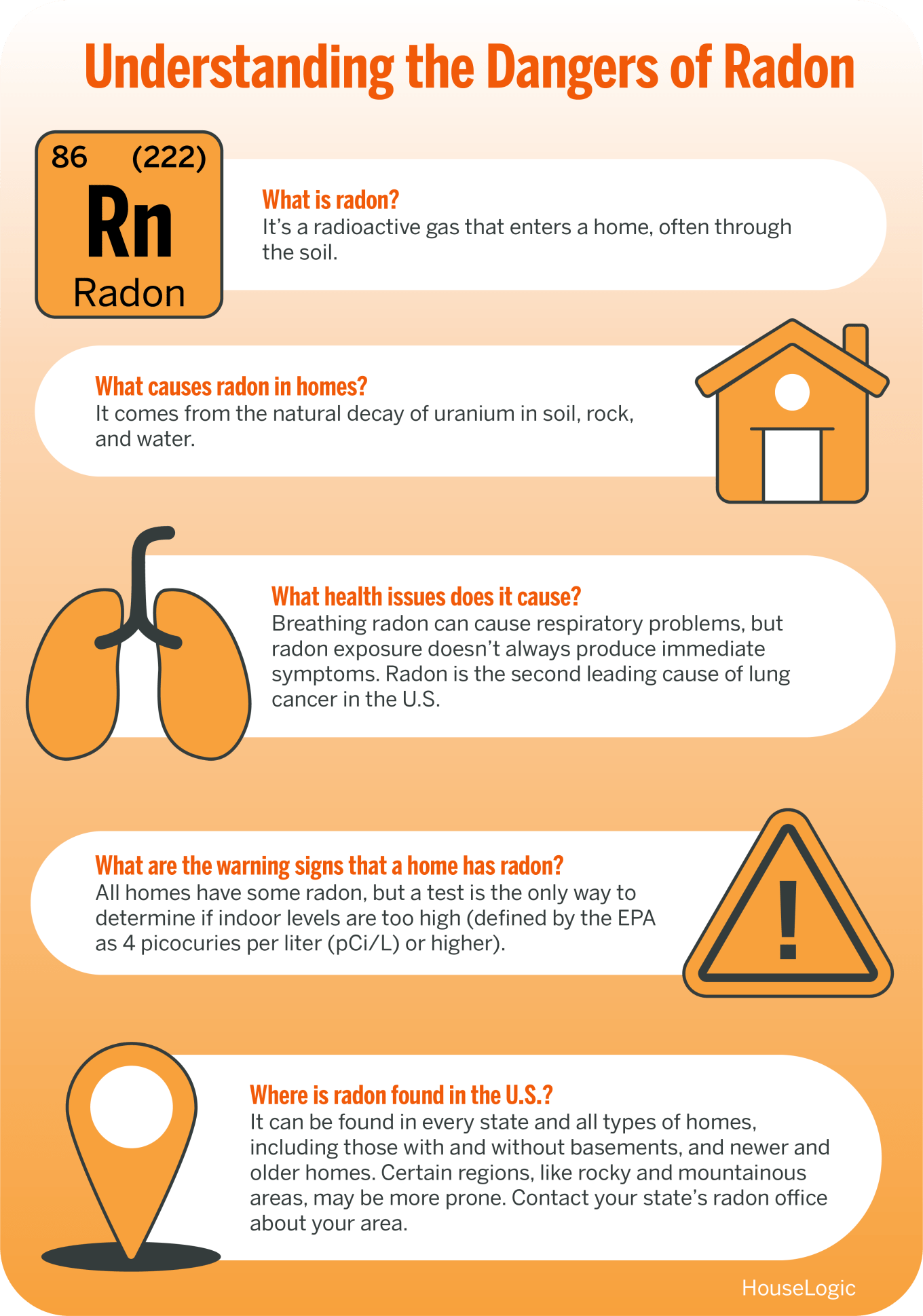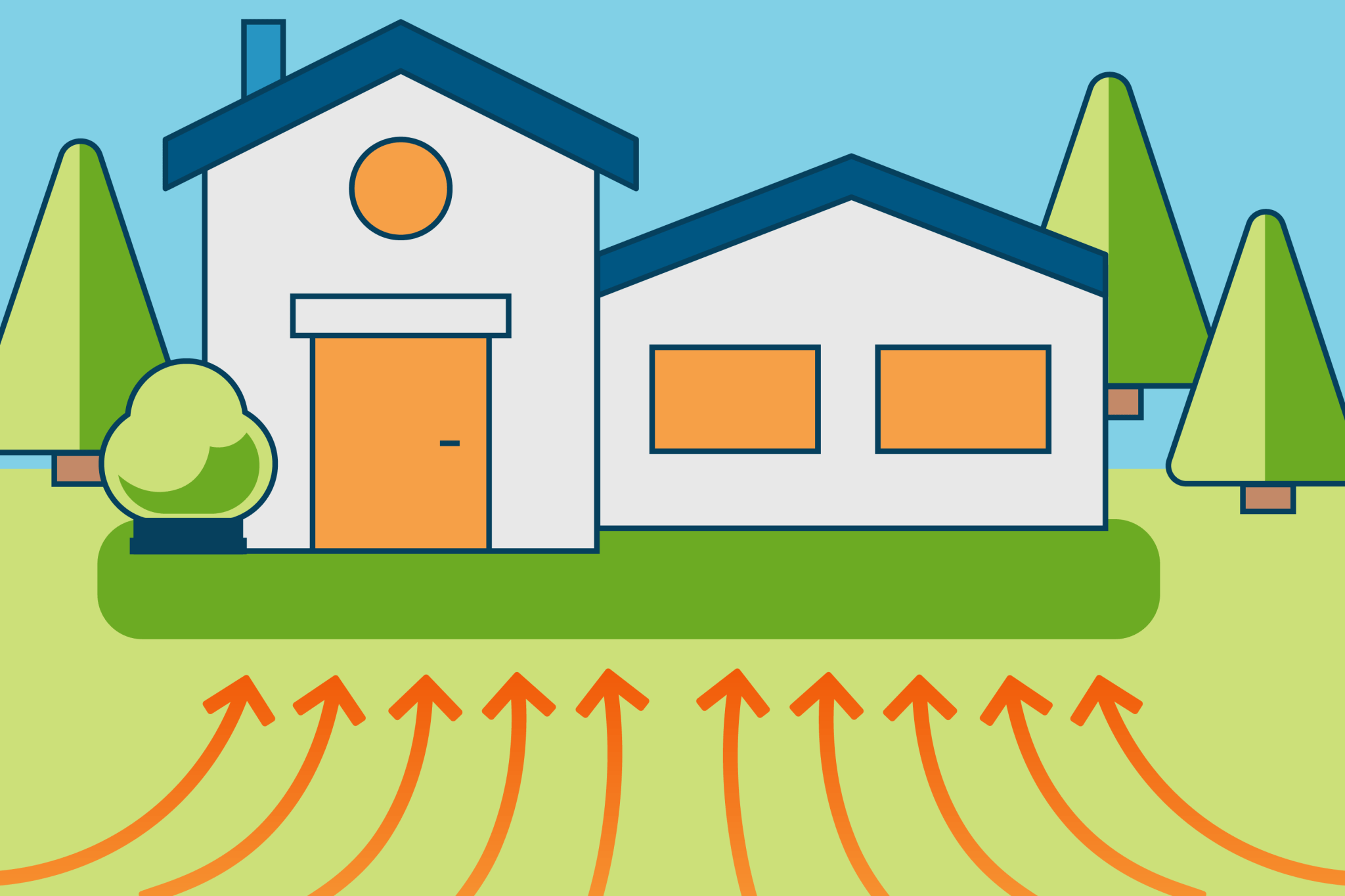You can’t smell it. Taste it. Or even see it. Yet, the Environmental Protection Agency estimates one of every 15 homes across the country has elevated levels of radon gas. Too often, though, homeowners don’t know about the radon risk until a test uncovers high levels. That can happen when they’re selling their house or, even worse, when they become sick. That’s why it’s so important to know about radon tests to detect high radon levels in your home and how to lower those levels through radon mitigation systems.
Any home could be at risk for having this dangerous radioactive gas, which enters a home’s air through the soil. But radon doesn't have to be a problem. It's preventable, and treatable with radon mitigation systems. The bigger problem is that homeowners and home buyers don't know about the dangers or dismiss them.
“There’s still an education gap with homeowners, buyers, and sellers on the risks of radon and helping them to understand how and when to have their home tested,” says Andrei Jablowkow, a home inspector and owner of WIN Home Inspection in Lansdale, Pa. The fact is that any home can have elevated radon levels, regardless of the home's size, region, or age.
Testing is the only way to know. You can easily find at-home, DIY tests or a professional radon test company that can provide more-thorough assessments. Here’s more about the dangers and why radon should be on your radar in real estate transactions.
Understanding the Dangers of Radon in Homes
Before we explore how to test and mitigate radon, here are questions and answers to help you understand why it's so dangerous:
- What is radon? Radon is a radioactive gas that enters a home, often through the soil.
- What causes radon in homes? It comes from the natural decay of uranium in soil, rock, and water.
- What health issues does it cause? Breathing radon over time can lead to respiratory problems, although no immediate symptoms may alert you that you’ve been exposed to it. Radon is the second leading cause of lung cancer in the U.S. It’s estimated to cause about 20,000 lung cancer deaths each year, according to the EPA.
- What are the warning signs that a home has radon? Radon can enter a home through cracks and holes in the foundation or even through well water. All homes have some radon, but a test is the only way to determine if indoor levels are too high (defined by the EPA as 4 picocuries per liter (pCi/L) or higher).
- Where is radon found in the U.S.? Radon can be found in every state and all types of homes, including those with and without basements, and newer and older homes. Certain geographic areas may be more prone, like mountainous and rocky areas, says Jay Rouse, owner of Pillar To Post Home Inspectors in Baltimore. Contact your state’s radon office to learn more about your area.
How Radon Can Affect Home Buying and Selling
Radon can present serious risk, but fortunately it doesn’t have to be a real estate deal-breaker. Investor Doug Greene, owner of Signature Properties in Philadelphia, says about half of the investment properties he considers have high levels of radon. His market has elevated radon concentrations, and he verifies testing of every home before and as part of a home inspection.
What to Know If You're a Home Buyer
You might expect radon testing to be in the scope of a standard home inspection, but it isn’t. That means if you’re a home buyer, you’ll need to request it. Be sure to check whether the home inspector has the specialized training and licensing to do the testing. A radon company can also test for radon levels.
What to Know If You're a Home Seller
Home sellers should have their home tested before listing it, says Jablowkow. That way, sellers can mitigate high levels before selling. Or “if radon levels are safe within the home, they can use that as a selling point to make their home more attractive to buyers,” he says.
If homeowners test for radon before listing, they’ll need to disclose the results to any home buyers. That applies regardless of whether results are positive or negative. Homeowners also need to tell buyers about the results of any tests that other potential buyers completed. Radon notification and disclosure laws differ by state and municipality. (The National Association of REALTORS® maintains a resource page on radon in real estate transactions, and the EPA offers the “Home Buyer’s and Seller’s Guide to Radon.” Also, this database breaks down state-by-state indoor air quality laws that include radon testing disclosure laws in real estate.)
How Radon Levels Can Affect Real Estate Negotiation
Buyers and sellers can negotiate the handling of radon in home sales. Home buyers may ask sellers to install a radon mitigation system if a home has elevated levels. “It has become normal practice in my area for a seller to fix the radon problem if it comes up during a home inspection,” Greene says. It's also sometimes negotiated as a concession, he adds.
“Nobody wants to live with being a stickler about deal negotiations and then have someone get sick from radon later on," Greene explains. Also, after a radon problem has been found in a house, that fact becomes public knowledge through property disclosure, he says. "So, any other buyer would know this now too. It’s better to just get it fixed than let a deal fall apart over it.”
‘But My Home Is Not at Risk’ and More Radon Myths
People often believe misconceptions about radon, such as:
Myth 1: Only older homes have radon problems.
Homes, regardless of age or foundation type, can have elevated radon levels. Developers may build newer homes with radon-resistant features. Options include plastic sheeting below the foundation, a vent pipe, or extra sealant of cracks. Even then, newer homes can still have high levels that may require further mitigation.
Myth 2: Radon in homes is only in the basement.
Radon can exist in homes with or without a basement. The EPA and the U.S. Surgeon General recommend testing all homes below the third floor, regardless of whether the area is finished.
Myth 3: You can lower radon levels by better ventilating your home, like opening the windows.
Natural ventilation methods, like opening windows, may slightly reduce levels, but results tend to be temporary. Experts say the most effective, lasting solution is to professionally install a radon system to vent spaces such as the basement or a crawl space.
Myth 4: You only need to test your home once for radon.
The EPA recommends testing a home for radon every two years.
Myth 5: Testing for radon can be costly.
At-home test kits are available from retail stores or online for about $20 to $30. A professional radon inspection typically costs an average $150 to $300, but depends on your region and home size, according to HomeAdvisor. Testing may span a minimum 48-hour period. More-extensive, professional tests may monitor levels over a seven-day or 90-day period.
How to Detect Radon
Testing is the only way to know your home’s radon levels. The two main testing types are:
- Passive radon detectors: These include charcoal canisters, alpha-track detectors, and electret ion chamber detectors. You can buy these at-home radon tests, which are often DIY, at retail stores or online. The tests measure the home’s indoor air over a specified time and a lab usually analyzes them.
- Active radon detectors: A professional radon testing company typically conducts this type of testing, which offers continuous radon monitoring. These detectors can reveal unusual swings in radon levels and the results are usually the most reliable, according to the EPA.
For professional radon testing, look for companies that specialize in radon testing or a home inspector who has completed additional training. You also can ask a real estate agent who is a REALTOR®, or member of the National Association of REALTORS®, for recommendations to local radon specialists. They're strong sources because radon often comes up in a real estate transaction. You may also get a list of radon testing companies from a state radon office (check out the EPA’s state-by-state list). Checking for professional certification by contacting the National Radon Proficiency Program, the National Radon Safety Board, or your state’s radon office.
How to Lower High Radon Levels
After a radon test is completed, your home will receive a reading expressed in picocuries per liter, or pCi/L. The EPA recommends lowering levels at or above 4 pCi/L for safer radon levels in the home. But even lower readings can carry risk. The World Health Organization advises keeping radon levels below 2.7 pCi/L.
You can slightly lower radon levels by sealing the foundation at all access points. That includes through plumbing and small cracks and mechanical ventilation, like the heat recovery ventilation system, says Rouse. Natural ventilation — like opening windows, doors, and vents. — is an option. "But that will literally leave your air quality and safety dependent on which way the wind blows,” he adds
Why Install a Radon Mitigation System?
Experts say the most effective, lasting way to lower indoor radon levels is by installing a radon mitigation system, which consists of a vent pipe and fan to vent radon outside. “[A system] gives them peace of mind that they’re protected from radon in their home," Jablowkow says. Also, just because the home didn’t have elevated levels of radon previously doesn’t mean it will stay like that. Radon levels can fluctuate throughout the seasons and years. That's why experts highly recommend routine testing.”
A professionally installed radon mitigation system can help reduce radon levels below 2 pCi/L. The installation doesn’t require major home renovations. Costs vary, but the national average is $1,200 for installation of a radon mitigation system, according to Angi. Even after installing a system, homeowners should recheck their levels to see if it’s working. Jablowkow recommends retesting homes with mitigation systems every five years.
Radon mitigation is not only a potentially life-saving investment, but could also be an asset in a real estate sale. Greene likes to see radon mitigation systems or prior testing completed in properties he considers purchasing. “It demonstrates that the person who owns the home cares about safety and wellness, which usually reflects on other aspects and features of the property.”

